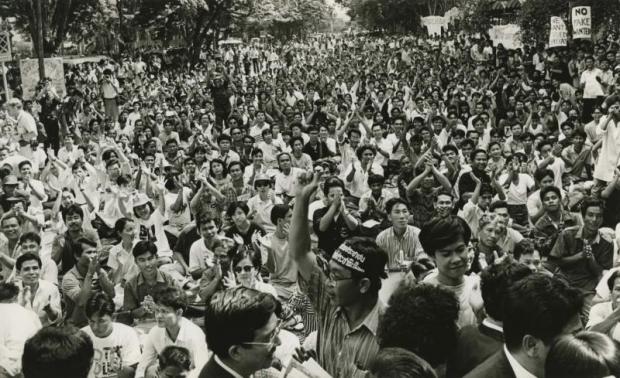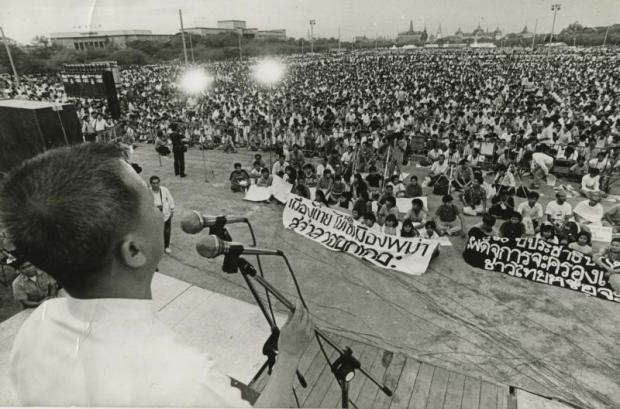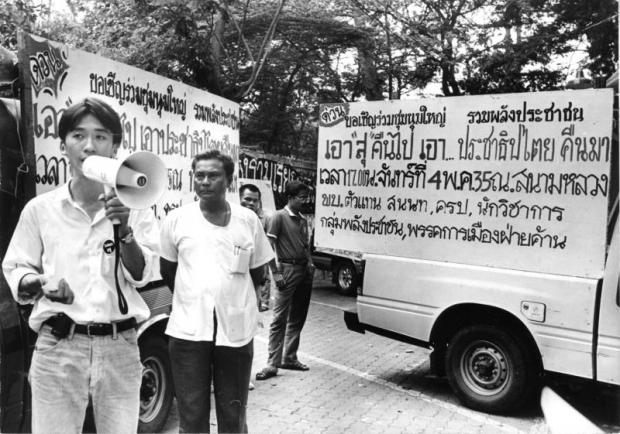
'You don't want to go down there," lamented one colleague. "There's bloody running street battles." It was Monday, May 18, 1992, and peaceful protests on the streets of Bangkok had taken an ominous turn. Military security personnel had opened fire on protesters the previous night, and Thailand's struggle to free itself from a seemingly endless cycle of military dictatorship was rapidly spiralling out of control.
We had been watching the newsroom television early in the evening as rioters commandeered city buses and drove them suicide-style towards army lines. Military hit squads were reportedly targeting aggressive motorcyclists. Fires broke out across the city as rock throwing gave way to Molotov cocktails.
Worst of all, there were reports that a petrol truck had been commandeered and was being escorted to Ratchadamnoen Avenue by an estimated 100 motorcycles to be used as a decisive weapon against itchy-fingered soldiers manning the barricades near the Democracy Monument.
Nevertheless, Australian colleague Chris Burslem and I and were determined to see for ourselves what was really happening that night on Ratchadamnoen. If only we could find a taxi willing to get us close. After an hour or so of failed attempts, Chris and I managed to hail a ride at five times the going rate. I wondered if we might be heading into the abyss.
I had landed my first newspaper job just a year earlier when I moved to Thailand from the US to join The Nation. Although I would go on to work for the Bangkok Post over the next decade, Bangkok was largely a mystery to me in 1992.
Our taxi plotted a labyrinthine course through nameless streets and alleys until we heard the first sounds of gunfire. End of the line. We exited the cab somewhere near Dusit. We were on our own.
Before we finished paying the driver, a police pickup screeched to a halt in front of our taxi. Twelve heavily armed men with helmets and bulletproof vests jumped out of the vehicle and pointed their weapons up into a building just overhead, let off a few short bursts and started scanning the windows of the apartments for an unseen perpetrator. We got out of there in a hurry.
As we walked south towards the Democracy Monument, the security tactics of the military and police revealed themselves. Protesters were being isolated into pockets, wherever they appeared, surrounded by barbed wire and manned checkpoints. We passed through several.
The largest of the pockets was eerily quiet. Hundreds of demonstrators slept in the street as their exhausted leader egged them on, fruitlessly, with moans from a bullhorn. It must have been around 2am and their night was over. Ours was just beginning.
We pushed on, passing a group of people hovered over a bloodstained patch on the footpath. One girl was sobbing as pops of gunfire echoed in the near distance. We dared not ask.
We arrived at the final checkpoint, just opposite the canal from Ratchadamnoen. A rock-jawed sergeant barked orders at us in Thai. We produced our press credentials. He harangued us for what felt like 10 minutes, pointing to the footpaths on both sides of the street. I understood very little. But according to Chris, he did not want us to walk down either footpath. He insisted we walk in the middle of the street, but not too far down.
It was then that I first spotted the suicide buses, each of them bullet-ridden and crashed every which way into trees and lamp posts. A bit further down I could make out the infamous petrol truck we were tracking back at the office. Its windows and tyres were blown out and the front cabin torched. It rested harmlessly against a tree.
Further down, light gunfire rang out sporadically around the public relations bureau building, which had been torched and was burning out of control.
Before us were hundreds, perhaps thousands, of troops asleep in the street in a strange repeat of the scene we had witnessed earlier in the night. They too appeared exhausted, cradling their weapons and apparently ambivalent to what was happening around them.
At about 4.30am, the army began to mobilise. The troops dragged themselves off the street and began to line up in columns stretching all the way back down the avenue.
To make room for them, a handful of journalists and photographers moved from the street to the pavement as the army marched forward. The image was one of awesome firepower: M16 rifles, belt-firing M60s, M89 grenade launchers, jeeps mounted with heavy machine guns, armoured personnel carriers with rapid-fire cannons. At one point I even saw a soldier with a clumsy-looking bazooka strapped to his back. Neither truncheons nor riot shields could be seen. These troops brought to the streets of Bangkok were a fully armed division headed into combat.
Thinking fast, Chris suggested we follow closely behind the last of the troops as they made their way to the front, and find an appropriate vantage point somewhere near the flashpoint. As the soldiers advanced, clicking and arming their weapons, a mass of bodies moved forward up the middle of the street towards the action around the Royal Hotel.
In choreographed sequence, the outside line of soldiers dropped in succession onto one knee and pointed their weapons up into the windows lining Ratchadamnoen in an anti-sniper formation. The columns marched forward between the rolling wave of the sniper lines. A few journalists, including my colleague, followed the troops into the middle just as the back of the sniper formation closed into a horseshoe, with the last of the soldiers pointing their rifles backwards. I was cut off by the last man in the formation. About five of us were left standing on the outside, with M16s pointed perilously close to our heads.
As I retreated back to the pavement along with the others, a squad of soldiers surrounded us and forced us to the ground. I wondered if they were military police. I thought about the barking sergeant. Then my shirt was pulled up over my head and I was pushed flat on my chest. An officer began yelling out questions in Thai with an intensity I understood more than the words. I raised my head to submit that I was a journalist, only to have it pushed back down. Shoulder to shoulder, the soldiers surrounded us in a tight circle as we lay on the ground. I wondered if we would disappear. All I could see >> >> were shiny boot toes, inches from my face. None of us said a word.
After confiscating our packs, the officer allowed us to sit up in order to bring out our press cards. Two of the four photographers were blindfolded and bound. The soldiers started ripping through their equipment, exposing each and every roll of film they found. The lead officer was bearing down on one of the photographers. I couldn't understand, but I knew the photographer's answers were not the correct ones when soldiers began kicking him in the back with their heavy boots. The blindfolded photographers grimaced but remained silent.
The crisis passed as the soldiers backed away from their successful efforts at intimidation and the circle of boots surrounding us moved away. We were allowed to sit on the pavement.
Soon the sky was lighting up with the neon streaks of tracer bullets and the chattering roar of hundreds of automatic weapons going off. There was no apparent pattern to the shooting; it was just an orgy of shooting. Fixed machine gun positions on the roofs above sent tracers flying off into the darkness towards Khao San Road. Only the lead officer's incessant yelling could be heard over the white noise of machine gun fire, which lasted well into the dawn.
Later, the morning sun revealed the youthfulness of our military guards, who only hours earlier had been faceless and terrifying drones.
The street was a particularly hellish scene. All around the seven or eight bullet-ridden buses, the street was littered with trash, broken glass, blood stains and discarded M16 cartridges. A couple of bare-chested tourists from Khao San Road were out, collecting bullet shells and snapping photos of the ill-fated petrol truck. I decided to make a move. I stood up and quietly walked towards the tourists, hoping to blend in and disappear. I was almost halfway there when the guards ran out and yanked me back. Dumb idea.
I sat back down and watched in disgrace as the army paraded T-shirt-bound protesters down the street to awaiting trucks, pushing and kicking them to the laughs and cheers of soldiers resting in front of us.
I caught a glimpse of Chris as he made his way back from the area around the Royal Hotel. I flagged him down and asked if he could speak to the guards and find out why I was being detained under guard. After a long conversation with one of the two head officers, he came back and told me I had stepped out of line somewhere and that it was nothing to worry about. All the officer needed to do was wait for his superior to come along and clear me and the others.
After the better part of an hour, a new group of soldiers came along and told us to get to our feet. We were then marched towards the Royal Hotel, with the occasional shoves to those who walked too slowly.
Outside the hotel we saw hundreds of protesters sitting cross-legged on the hot pavement, their hands tied behind their backs with T-shirts and heads bowed. A soldier forcefully took my shirt off and fastened my hands behind my back. I tried to explain to him that I was a journalist as he forced me down onto the pavement.
Chris, who had followed along to act as my intermediary, stepped in to help. But he too was tied up and forced down onto the footpath. Several protesters turned their heads towards us in bewilderment. We were the only farangs in sight. A teenager in front of me gave me a friendly nod, only to have his head shoved back down by one of the guards.
After watching the military parade around all morning as if evil invaders had just overrun the country's borders, the absurdity of all this whole thing was more than I could fathom. This wasn't a war. These weren't enemies. The army had brought out all this overwhelming firepower against these people -- their own people, the ones who were risking everything for their fair chance at democracy.
One of the photographers, whom I had been with all night, was pushed down next to me. He slumped down and began to cry. After some time, a new group of soldiers approached me and asked to see my ID. I pointed to my pocket. One of the soldiers drew out my wallet, then after much fumbling retrieved my press card.
"I'm sorry, I'm sorry," he said, untying my hands. "You can go now." I put my shirt on and tried as best as I could to console the poor photographer and wish him well. As I turned to leave, I looked back at the teenager, who, from behind his back, flashed me the victory sign. n
Scot Donaldson worked for The Nation from 1991 to 1996 before joining the Bangkok Post. He served as a sub-editor and later design editor at the Post from 1996 to 2001.

TENSE TIMES: Police stand guard as demonstrators gather in front of the parliament building.

MASS UPRISING: At the height of the protest 200,000 people filled Sanam Luang. Gen Suchinda Kraprayoon resigned as prime minister on May 24 after an intervention by King Bhumibol Adulyadej.

HAILING A NEW ERA: Protesters campaign to get rid of PM Suchinda Kraprayoon.

FLASHPOINT: Demonstrators move fences on Ratchadamnoen Avenue during the Black May uprising.

CLAMPDOWN: Soldiers arrest a demonstrator during the height of the Black May uprising.

A MONK'S TALE: Soldiers stand guard at the Democracy Monument before the violence that claimed many lives.